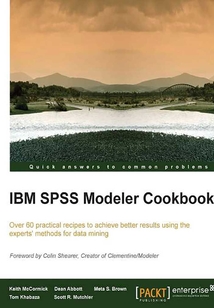舉報 

會員
IBM SPSS Modeler Cookbook
最新章節:
Index
Thisisapracticalcookbookwithintermediate-advancedrecipesforSPSSModelerdataanalysts.Itisloadedwithstep-by-stepexamplesexplainingtheprocessfollowedbytheexperts.Ifyouhavehadsomehands-onexperiencewithIBMSPSSModelerandnowwanttogodeeperandtakemorecontroloveryourdataminingprocess,thisistheguideforyou.Itisidealforpractitionerswhowanttobreakintoadvancedanalytics.
目錄(93章)
倒序
- 封面
- 版權信息
- Credits
- Foreword
- About the Authors
- About the Reviewers
- www.PacktPub.com
- Preface
- Chapter 1. Data Understanding
- Introduction>
- Using an empty aggregate to evaluate sample size>
- Evaluating the need to sample from the initial data>
- Using CHAID stumps when interviewing an SME>
- Using a single cluster K-means as an alternative to anomaly detection>
- Using an @NULL multiple Derive to explore missing data>
- Creating an Outlier report to give to SMEs>
- Detecting potential model instability early using the Partition node and Feature Selection node>
- Chapter 2. Data Preparation – Select
- Introduction>
- Using the Feature Selection node creatively to remove or decapitate perfect predictors>
- Running a Statistics node on anti-join to evaluate the potential missing data>
- Evaluating the use of sampling for speed>
- Removing redundant variables using correlation matrices>
- Selecting variables using the CHAID Modeling node>
- Selecting variables using the Means node>
- Selecting variables using single-antecedent Association Rules>
- Chapter 3. Data Preparation – Clean
- Introduction>
- Binning scale variables to address missing data>
- Using a full data model/partial data model approach to address missing data>
- Imputing in-stream mean or median>
- Imputing missing values randomly from uniform or normal distributions>
- Using random imputation to match a variable's distribution>
- Searching for similar records using a Neural Network for inexact matching>
- Using neuro-fuzzy searching to find similar names>
- Producing longer Soundex codes>
- Chapter 4. Data Preparation – Construct
- Introduction>
- Building transformations with multiple Derive nodes>
- Calculating and comparing conversion rates>
- Grouping categorical values>
- Transforming high skew and kurtosis variables with a multiple Derive node>
- Creating flag variables for aggregation>
- Using Association Rules for interaction detection/feature creation>
- Creating time-aligned cohorts>
- Chapter 5. Data Preparation – Integrate and Format
- Introduction>
- Speeding up merge with caching and optimization settings>
- Merging a lookup table>
- Shuffle-down (nonstandard aggregation)>
- Cartesian product merge using key-less merge by key>
- Multiplying out using Cartesian product merge user source and derive dummy>
- Changing large numbers of variable names without scripting>
- Parsing nonstandard dates>
- Parsing and performing a conversion on a complex stream>
- Sequence processing>
- Chapter 6. Selecting and Building a Model
- Introduction>
- Evaluating balancing with Auto Classifier>
- Building models with and without outliers>
- Using Neural Network for Feature Selection>
- Creating a bootstrap sample>
- Creating bagged logistic regression models>
- Using KNN to match similar cases>
- Using Auto Classifier to tune models>
- Next-Best-Offer for large datasets>
- Chapter 7. Modeling – Assessment Evaluation Deployment and Monitoring
- Introduction>
- How (and why) to validate as well as test>
- Using classification trees to explore the predictions of a Neural Network>
- Correcting a confusion matrix for an imbalanced target variable by incorporating priors>
- Using aggregate to write cluster centers to Excel for conditional formatting>
- Creating a classification tree financial summary using aggregate and an Excel Export node>
- Reformatting data for reporting with a Transpose node>
- Changing formatting of fields in a Table node>
- Combining generated filters>
- Chapter 8. CLEM Scripting
- Introduction>
- Building iterative Neural Network forecasts>
- Quantifying variable importance with Monte Carlo simulation>
- Implementing champion/challenger model management>
- Detecting outliers with the jackknife method>
- Optimizing K-means cluster solutions>
- Automating time series forecasts>
- Automating HTML reports and graphs>
- Rolling your own modeling algorithm – Weibull analysis>
- Appendix A. Business Understanding
- Introduction>
- Define business objectives by Tom Khabaza>
- Assessing the situation by Meta Brown>
- Translating your business objective into a data mining objective by Dean Abbott>
- Produce a project plan – ensuring a realistic timeline by Keith McCormick>
- Index 更新時間:2021-07-23 16:01:53
推薦閱讀
- 中國新股民必讀手冊(2015年最新版)
- Microsoft Dynamics GP 2016 Cookbook
- Pentaho Business Analytics Cookbook
- Splunk:Enterprise Operational Intelligence Delivered
- 企業能源審計與節能規劃
- 大數據搜索與挖掘及可視化管理方案 :Elastic Stack 5:Elasticsearch、Logstash、Kibana、X-Pack、Beats (第3版)
- 財務審計實務指南
- 非線性經濟關系的建模
- Salesforce Essentials for Administrators
- 2016年度注冊會計師全國統一考試專用輔導教材(圖解版):審計
- vSphere Design Best Practices
- 新編統計學
- 成功通過PMP(第3版)
- 陜西國家統計調查市、縣優秀報告集萃(2006—2015)(上下)
- 高級計量經濟分析及Stata應用
- 企業內部審計全流程指南
- 內審兵法
- 內部審計情景案例:理解審計行為,辨析審計決策
- 統計原理與實務
- 財務會計習題集
- 多項目管理方法及其應用研究(國家社科基金后期資助項目)
- Citrix Access Gateway VPX 5.04 Essentials
- 事業單位內部控制
- 數量經濟研究(2019年第10卷/第3期)
- 拯救經濟計量學:由概率論方法轉向概率近似正確學習
- 生活中的統計學
- Learning Windows Azure Mobile Services for Windows 8 and Windows Phone 8
- Implementing Citrix XenServer Quickstarter
- 審計學(第2版)
- 國民經濟核算理論與中國實踐

